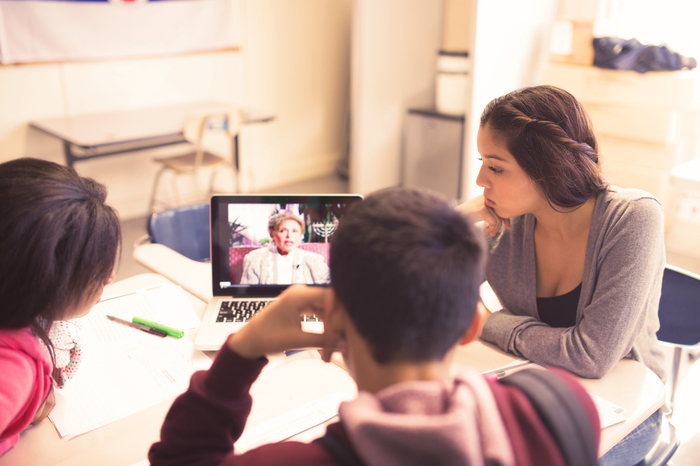
HOLOCAUST EDUCATION
SURVIVORS

One of the most powerful exhibits I’ve ever experienced about the Holocaust is at the site of what was once the Auschwitz-Birkenau death camp in Poland.
Here, in the installation by Yad Vashem at Block 27, the deeply human story is told through flickering film footage of Jews living ordinary lives in Europe before World War II: a young girl ice skating, children singing and dancing.
The story is also told through video testimony of Jews who survived, through giant pages listing the millions of names of those who didn’t, and through drawings on the walls.
Viewers are left with the gut-wrenching reality that the Shoah destroyed real people with real names and real lives.
That some aspects of the exhibit were technologically sophisticated and others were devoid of technology is entirely incidental to the experience.
In the sphere of remembrance, technology should never be a “thing” in its own right. Stories, really, are the thing. They are at the heart of how we talk to each other, share memories, transmit understanding. Technology has always been in service of that human function. It is a utility to help tell our stories and deliver our content. Within Echoes & Reflections, for example, visual history testimonies from survivors and other witnesses to the Holocaust, were carefully curated from USC Shoah Foundation’s Visual History Archive, and embedded within each classroom lesson and theme to bring the history to life with real people who lived through this event.
This month and next, as students return to school, I ask educators to bear this message in mind. Students from toddlers to twentysomethings exist in a virtual matrix of gadgets, video games and social media accounts.
This is natural. Media, like fashion, is ever changing. The trick is to use the latest technology to meet the students where they are, and to deliver to them stories that illuminate.
It was with this intention that USC Shoah Foundation has embarked on several technological innovations.
Our 2016 documentary, “The Last Goodbye,” is the first virtual-reality film to take audiences through a concentration camp. The power of it lies not in the capability to capture a scene in 360 degrees, but in the immersive experience of being in the Majdanek death camp with the narrator, Pinchas Gutter, the only member of his family of four to survive the camp in Poland. Adding to the authenticity of the experience is the fact that Gutter was filmed not on a green screen in some studio, but on site. When he is standing at the door of the gas chamber where his sister was murdered, there is no escaping the terrible truth of what that place means in his memory.
In this same spirit, we have recorded more than a dozen testimonies using a technology we developed that allows users to interact with the survivors on a screen. (The interviewees were filmed volumetrically, meaning it will one day be possible to reconstruct their images into holograms.) Called Dimensions in Testimony, these interactive biographies enable viewers to be guided by their own curiosity; to take an inquisitive approach to learning a survivor’s story, in the same way we do when we see a Holocaust survivor speak to a classroom.
Technology is not the message. It is what our audiences experience that really counts.
About the author: Stephen D. Smith, PhD, is the Andrew J. and Erna Finci Viterbi Executive Director Chair of the USC Shoah Foundation.




This site contains links to other sites. Echoes & Reflections is not responsible for the privacy practices or the content of such Web sites. This privacy statement applies solely to information collected by echoesandreflections.org.
We do not use this tool to collect or store your personal information, and it cannot be used to identify who you are. You can use the Google Analytics Opt-Out Browser Add-on to disable tracking by Google Analytics.
We currently do not use technology that responds to do-not-track signals from your browser.
Users may opt-out of receiving future mailings; see the choice/opt-out section below.
We use an outside shipping company to ship orders. These companies are contractually prohibited from retaining, sharing, storing or using personally identifiable information for any secondary purposes.
We may partner with third parties to provide specific services. When a user signs up for these services, we will share names, or other contact information that is necessary for the third party to provide these services.
These parties are contractually prohibited from using personally identifiable information except for the purpose of providing these services.
1. You can unsubscribe or change your e-mail preferences online by following the link at the bottom of any e-mail you receive from Echoes & Reflections via HubSpot.
2. You can notify us by email at info@echoesandreflections.org of your desire to be removed from our e-mail list or contributor mailing list.






 English
English